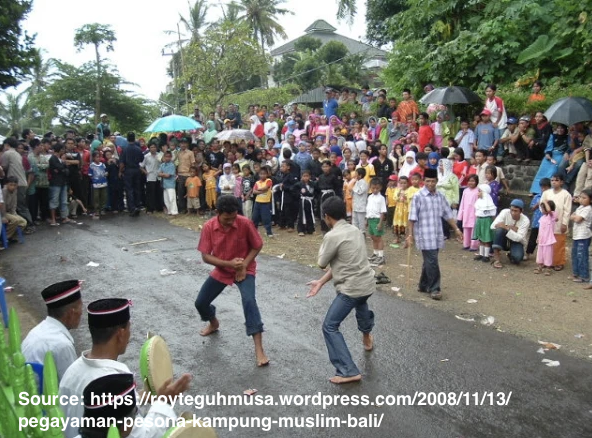Abstract
The stigmatization of the Pegayaman Muslim community has resulted in various forms of violence, both physical and symbolic. The aim of this study is, therefore, to examine how the Pegayaman Muslim community fights stigma by building a positive self-image in the structure of a pluralistic society in Buleleng, Bali. Furthermore, the data used in this study was collected through observation, in-depth interviews, and documentation studies by increasing the number of researchers on the field and analyzed using a three-phase interpretive-critical approach, namely data reduction, data presentation, and verification. The results revealed that the Pegayaman Muslim community faced stigmatization as a result of historical experiences; religious and ethnic ideological discourses; and the construction of reality for various interests. There were different forms of stigma ranging from labeling to discrimination in various social practices. The community responded to this stigma by building a positive self-image. Also, the inhabitants sought to improve their quality of life through economic empowerment, educational awareness, the establishment of Islamic values, building an image as an inclusive and tolerant Islamic community, creating a cohesive space for communication and interaction with the surrounding peoples, and optimizing the role of the media. In this situation, it was found that self-image is an effective strategy that can be used in curbing the inherent stigmawhile increasing the dignity of the inhabitants of a multicultural society.
References
Abadi Mansyur. (2012). Pesantren Desa Pegayaman, Meleburnya Jagad Bali dalam Kearifan Islam. Jakarta: LIPI.
Ahmad, Risdawati, J. H. Gita Purwasih, Irawan. (2020). “Strategi pemuda Gang Tato Desa Kemantren Kabupaten Malang melawan stigma sosial”. Jurnal Teori dan Praktis Pembelajaran IPS, Vol. 5, No. 2; Oktober 2020, hal. 63—78.
Aminuddin, Ahsani, T. (2022). “Performa Komunikatif Takmir Melawan Stigma Negatif dan Penyebaran Paham Terorisme di Masjid”. KAGANGA KOMUNIKA: Journal of Communication Resarch, Vol. 4, No. 1, Mei 2022, hal. 12—21.
Andrini, S. (2006). “Stereotif Masyarakat Pegayaman Dalam Komunikasi Antar Budaya: Sebuah Kajian Budaya”. Tesis tidak dipublikasikan. Denpasar: Program Magister Kajian Budaya, Universitas Udayana.
Arif, Muhammad. (2016). “Analisis Faktor Integrasi Sosio-Kultural-Historis pada Masyarakat Multikultural”. SOSIO DIDAKTIKA: Social Science Education Journal, 3 (2), 2016, hal. 126—134.
Aryantini, Putu Dewi, A. A. Ngurah Anom Kumbara, Ni Luh Arjani. (2018). “Stigmatization Toward Tattooed Balinese Women in Denpasar”. E-Journal of Cultural Studies, November 2018 Vol. 11, Number 4, Page 17—24.
Atmadja, Nengah Bawa, (2010). Ajeg Bali Gerakan, Identitas Kultural, dan Globalisasi. Yogyakarta: LKiS.
Barth, Fredrik. (1993). Balinese Worlds. The University of Chicago Press.
Basri, Muhammad R. (2021). “Melawan Stigma Radikal: Studi Gerakan Perempuan Bercadar di Instagram”. APLIKASIA: Jurnal Aplikasi Ilmu-ilmu Agama, Volume 21, Nomor 2, 2021, hal. 147—164.
Becker, H. S. (1963). Outsiders: Studies in the sociology of deviance. Free Press Glencoe.
Bourdieu, Piere. (1991). Language and Symbolic Power. Cambridge: Harvard University Press.
_______. (2010). Arena Produksi Kultural Sebuah Kajian Sosiologi Budaya. (Yudi Santoso penerjemahan. Bantul: Kreasi Wacana Offset
Budarsa, Gede. (2014). “Penyerapan Unsur-unsur Budaya Bali pada Masyarakat Islam di Desa Pegayaman, Kecamatan Sukasada, Buleleng-Bali”. Skripsi. Denpasar: Universitas Udayana.
Budarsa, Gede. (2020). “Karakteristik Budaya Komunitas Islam Pegayamman, Buleleng”. Tesis. Denpasar: Program Magister Kajian Budaya, Universitas Udayana.
Burhanudin, Yudhis. M. 2008. Bali yang Hilang: Pendatang, Islam dan Etnisitas di Bali. Yogyakarta: Kanisius.
Dyer, Richard. (1999). “The Role of Stereotypes”, in Paul Marris and Sue Thornham (Editors), Media Studies: A Reader, (2nd Edition). Edinburgh University Press.
Foucault, Michel. (1980a). Power/Knowledge. New York: Pantheon.
______. 1980b. Dicipline and Punish. New York: Vintage Books.
Fulthoni, M.Y, dkk. (2009). Memahami Diskriminasi: Buku Saku Kebebasan Beragama. Jakarta: The Indonesia Legal Resource Center (ILRC).
Geertz, C. (1973). The Interpretation of Cultures. New York: Basic Books Inc. Publisher.
Goffman, E. (1963). Stigma: Notes on the Management of Spoiled Identity. Prentice-Hall.
Hariyono, P. (1993). Kultur Cina dan Jawa: Pemahaman Menuju Asimilasi Kultural. Jakarta: Pustaka Sinar Harapan.
Kartaningdryani, Inestya. (2019). “Heteronormativitas, Wacana LGBT dan Perjuangan Komunitas Waria Melawan Stigma”. Jurnal Pemikiran Sosiologi, Vol. 6, No. 2 (2019), hal. 191—209.
Kartini, Indriana. (2011). “Dinamika Kehidupan Minoritas Muslim di Bali”. Jurnal Masyarakat Indonesia, Edisi XXXVII, No.2, 2011, hal., 115—145.
Kumbara, A. A Ngurah Anom. (2010). “Konstruksi Wacana Ajeg Bali dalam Relasi Kuasa: antara Ideologi dan Utopia”. Pidato Pengukuhan Guru Besar Tetap dalam Bidang Epistimologi Antropologi pada Fakultas Sastra Universitas Udayana, Sabtu 6 Nopember 2010.
Kumbara, A. A. Ngr Anom; A. A. S. Kartika Dewi. (2022). “The Resistance of the Pegayaman Islamic Community Against Stigma and Identity Retention Strategies In Buleleng Regency”. E-Journal of Cultural Studies, May 2022 Vol. 15, Number 2, Page 49-58.
Link, Bruce G. and Jo, C. Phelan. (2001). “Conceptualizing Stigma”. Annual Review of Sociology, Vol. 27 (2001), pp. 363-385.
Lubis, Akhyar Yusuf. (2006). Dekonstruksi Epistemologi Modern, Dari Posmodernisme, Teori Kritis, Poskolonialisme Hingga Cultural Studies. Jakarta: Pustaka Indonesia Satu.
Maliki, Zainuddin. (2008). Sosiologi Pendidikan. Yogyakarta: Gadjah Mada University Press.
Mashad, Dhurorudin. (2014). Muslim Bali Mencari Kembali Harmoni yang Hilang. Jakarta: Pustaka-Al Kautsar.
Miles, Mathiew B. dan Michael Huberman. (1992). Analsis Data Kualitatif. Jakarta: Universitas Indonesia
Nottingham, Elizabeth K. (2022). Agama dan Masyarakat: suatu pengantar sosiologi agama. Jakarta: Rajawali.
Pageh, I Wayan. (2013). Interaksi Nyama Selam dan Hindu di Kabupaten Buleleng. Singaraja: Undiksha: Laporan Penelitian.
Sastrodiwiryo, Soegianto. (2022). I Gusti Anglurah Panji Sakti: Raja Buleleng 1599—1680. Cetakan ke-2. Denpasar: Pustaka Bali Post.
Scharf, Betty R. (2004). Kajian Sosiologi Agama. Yogyakarta: Tiara Wacana.
Scott, James. (2004). Senjata Perlawanan orang-orang Kalah. Yogyakarta: Pustaka Pelajar.
Spradley, James P. (1997). Metode Etnografi. Yogyakarta: Tiara Wacana.
Sukiada, I Nyoman. (2007). “Peranan Sejarah Lokal dalam Membangun Multikulturalisme di Indonesia”. Jurnal Ilmiah Dharma Smerti, Edisi April 2007, hal. 20-29.
Windia, Wayan P. (2021). Kamus Adat Bali. Denpasar: Setia Bhakti.

This work is licensed under a Creative Commons Attribution-NonCommercial 4.0 International License.
Copyright (c) 2022 ETNOSIA : Jurnal Etnografi Indonesia





